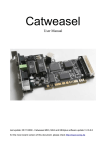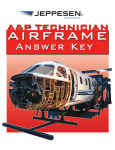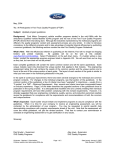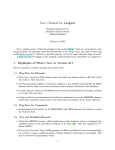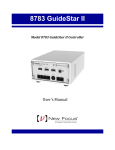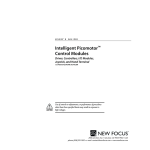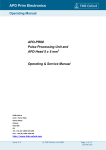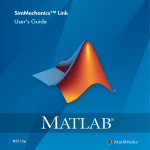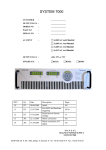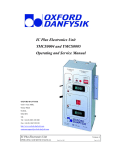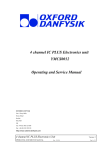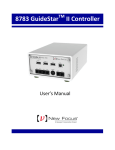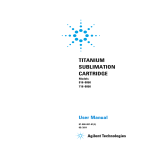Download S1107 NE-CAT HBM - USER MANUAL-01
Transcript
User Manual Horizontal Bouncing Monochromator For NE-CAT (Project S1107) February 2006 Version 1.0 Oxford Danfysik Unit 1 Ferry Mills Osney Mead, Oxford Oxon OX2 OES, UK Tel: +44 (0)1865 320300 Fax: +44 (0)1865 320301 http://www.oxford-danfysik.com Page 1 Important Information This technical manual is intended to help the user operate the Horizontal Bouncing Monochromator (HBM) manufactured by Oxford Danfysik. Before attempting to operate the system, PLEASE READ THE INSTRUCTIONS. This product should only be used by persons trained and authorised to do so. Warranty Products of Oxford Danfysik are warranted to be free from all defects in materials and workmanship. The liability of Oxford Danfysik under this guarantee is limited to servicing, adjusting or replacing defective parts. The guarantee is effective for one year from the date of dispatch to the original purchaser, provided: 1. The product is returned to the factory and undamaged by failure to provide sufficient packaging. 2. The product appears to Oxford Danfysik's satisfaction to be defective through no fault of the user. 3. The equipment has been handled and operated in accordance with the instructions and advice given in this manual or any other instructions, which have been provided by Oxford Danfysik. 4. Customer Returns Authorization must be obtained from Oxford Danfysik before returning any item for service or repair. Important Health and Safety Notice When returning components for service or repair, it is essential that the item is shipped together with a signed declaration that the product has not been exposed to any hazardous contamination, or that appropriate decontamination procedures have been carried out so that the product is safe to handle. Feedback Care has been taken to ensure the information in this manual is accurate and at an appropriate level. Please inform Oxford Danfysik if you have any suggestions for corrections or improvements to this manual. Trademarks Oxford Danfysik acknowledges all trademarks and registrations. Copyright Copyright 2006 Oxford Danfysik Beamlines Limited. All rights reserved. No part of this document may be reproduced or distributed in any form, or by any means, or stored in a database or retrieval system, without prior written permission of Oxford Danfysik. Page 2 Contents Important Information ............................................................................................ 2 Contents................................................................................................................. 3 Table of Figures ..................................................................................................... 5 1 Health and Safety Information .......................................................................... 6 1.1 General ...............................................................................................................................6 1.2 Electrical Safety..................................................................................................................6 1.2.1 Potential Electrical Hazards.........................................................................................6 1.2.2 Recommended Precautions ........................................................................................7 1.2.3 First Aid ........................................................................................................................7 X-rays ...........................................................................................................................................7 1.3 Mechanical Handling Safety...............................................................................................8 1.4 Safe Mechanical Practice...................................................................................................8 1.5 Moving parts .......................................................................................................................8 1.6 Vacuum...............................................................................................................................8 1.7 Modifications and service...................................................................................................9 2 Introduction .................................................................................................... 10 2.1 Scope................................................................................................................................10 2.2 How To Use This Manual.................................................................................................10 2.3 System Description ..........................................................................................................10 2.3.1 Crystal Cage ..............................................................................................................13 2.3.2 Vacuum System.........................................................................................................13 2.4 General information..........................................................................................................13 2.4.1 Weight ........................................................................................................................13 2.4.2 Lifting Arrangements..................................................................................................13 2.4.3 Alignment ...................................................................................................................14 2.5 Definitions and References ..............................................................................................14 3 Crystal Cage ................................................................................................... 15 3.1 Scope of Supply ...............................................................................................................15 3.1.1 Crystals Specification ................................................................................................15 3.1.2 Crystal Assembly & Cooling ......................................................................................16 3.1.3 Crystal Mounts and Compton Shielding....................................................................16 3.2 Crystal Cage Mechanism.................................................................................................17 3.2.1 General Description of the Crystal Cage Assembly..................................................17 3.2.2 Crystal Cage Actuators and Controls ........................................................................17 3.2.2.1 3.2.2.2 Motorised Crystal Adjustments...................................................................................................................17 Swing and vertical translation.....................................................................................................................19 3.2.3 Crystal Cage Materials ..............................................................................................20 3.3 Controls ............................................................................................................................21 3.3.1 Picomotor Controller ..................................................................................................21 3.3.2 Stepper Motor ............................................................................................................21 3.3.3 Nanomotor Controller ................................................................................................21 3.3.4 Cables ........................................................................................................................21 4 Vacuum System.............................................................................................. 22 4.1 Page 3 Specifications ...................................................................................................................22 4.1.1 4.1.2 4.1.3 4.1.4 4.1.5 4.1.6 4.1.7 4.1.8 5 General Description ...................................................................................................22 Vessel ........................................................................................................................22 Cryogenic Feedthrough.............................................................................................24 Water Feedthrough for Crystal Cage Stabilisation....................................................24 Vessel Base ...............................................................................................................24 Partial Vacuum Interlock Requirement......................................................................24 Support Frame ...........................................................................................................24 Aperture Plates ..........................................................................................................25 Documentation and Testing............................................................................ 27 5.1 Documentation .................................................................................................................27 5.2 Testing..............................................................................................................................27 5.2.1 Factory testing ...........................................................................................................27 5.2.2 On-site Testing...........................................................................................................27 5.3 Installation ........................................................................................................................28 6 Summary of the Scope of Supply ................................................................... 29 6.1 Crystal Cage.....................................................................................................................29 6.1.1 Items not Included .....................................................................................................29 6.2 Vacuum System ...............................................................................................................29 6.2.1 Items not Included .....................................................................................................29 6.3 Other Items.......................................................................................................................30 References ........................................................................................................... 31 Page 4 Table of Figures Figure 2.1 Cryogenically cooled copper block supporting monochromator crystals. ............................... 11 Figure 2.2 Front view at the HBM....................................................................................................... 11 Figure 2.3 Vacuum vessel of HBM..................................................................................................... 12 Figure 2.4 Base plate of the vessel. ................................................................................................... 12 Figure 2.5 System of co-ordinates. .................................................................................................... 14 Figure 3.1 Design of Silicon crystals. ................................................................................................. 16 Figure 3.2 Rear view of the monochromator. ...................................................................................... 18 Figure 3.3 Stepper motors providing vertical translation and fine pitch of the crystals. ........................... 18 Figure 3.4 Cable connectors at the side of the synthetic granite plinth. ................................................. 21 Figure 4.1 Cooling system of the HBM. .............................................................................................. 25 Figure 4.2 Temperature stabilisation line (bottom of the crystals). ........................................................ 26 Figure 4.3 Tungsten apertures........................................................................................................... 26 Page 5 1 Health and Safety Information 1.1 General In normal operation, the system is designed to operate safely. The user should, however, be aware of potential hazards that exist in and around equipment of this type and of the ways of avoiding possible injury and equipment damage which may result from inappropriate ways of working. A description of such potential hazards and how to avoid them is given in this section. If the equipment is used in a manner not specified in the User Manual, the protection provided by the equipment may be impaired. This manual adopts the following convention: WARNING Indicates a potential hazard which may result in injury or death CAUTION Indicates a potential hazard which may result in damage to equipment WARNING Do not take risks. You have a responsibility to ensure the safe condition and safe operation of equipment. See original manufacturers manuals for further safety data on third party equipment supplied with the system. 1.2 Electrical Safety In normal use the user is protected from the dangers associated with the voltage, current and power levels used by the equipment. Only personnel qualified to work with the currents and voltages involved should work on the electrical equipment. 1.2.1 Potential Electrical Hazards The following list shows the range of potential hazards that exist on the system; however, it is not intended as a complete guide to all the electrical hazards such as • Electric shock • Electric burn • Fire of electrical origin • Electric arcing . Page 6 1.2.2 Recommended Precautions WARNINGS 1. All of the electrical equipment supplied as part of the system should be provided with a protective ground. Do not remove protective grounds as this may give rise to an electrical safety hazard. It is vitally important that the vacuum system is properly grounded at all times. 2. Follow local and national electrical regulations and procedures. 3. Do not defeat interlocks, remove connectors, disconnect equipment, open safety covers, dismantle or modify equipment unless you are qualified and authorised to do so and you are fully conversant with its operation and potential hazards or have total assurance through your local electrical permit to work system that the equipment has been made safe. 4. Make sure that the mains supply is fused at an appropriate rating and that it can be isolated locally via a clearly labelled, clearly visible and easily accessible isolating switch. Isolate the supply before carrying out any maintenance work. 1.2.3 First Aid A course in first aid, which includes methods of artificial respiration, is recommended for those whose work involves equipment that may produce high voltages. WARNINGS 1. Do not attempt to administer first aid to someone who may have suffered electric shock until the source of the shock has been isolated. 2. Mains voltages are present in the system. These can cause serious injury or death. 3. Only qualified and experienced personnel should perform service or maintenance work on this equipment. X-rays WARNING This equipment is intended for use on a synchrotron source x-ray beamline. Ensure that safe working practices relating to radiation are employed. Follow any local, national or international rules and guidelines. The manufacturer will not be held responsible for the safety of personnel injured by ionizing radiation as a result of inadequacy of the customer's own radiation protection system. Page 7 1.3 Mechanical Handling Safety WARNINGS 1. Lifting points and jigs are provided for safe handling of components and safe handling practice must be observed to comply with local regulations. 2. Check that lifting points are used only for the job intended. 3. The system itself and some components are heavy and require careful handling. Use safe lifting procedures for heavy items to prevent possible strain injury. 1.4 Safe Mechanical Practice In normal use personnel are not required to undertake mechanical work. However, servicing or repair may necessitate access to any part of the system. Only suitably qualified personnel should attempt to dismantle, modify or repair equipment. Water connections should be made and tested in accordance with any local and national safety regulations. 1.5 Moving parts There is a number of moving parts in the system which are powered by compressed air or electric motors. WARNING Injury could result if clothing or body parts become caught in moving mechanisms. Keep clothing, hands and others body parts away from moving mechanisms. 1.6 Vacuum WARNINGS 1. Vacuum components can fail and cause implosion which can result in injury. There is a risk of injury due to flying glass if a viewport shatters under vacuum. Use viewport covers if viewports exist and wear eye protection. 2. If the vacuum system is over pressurised, vacuum components such as viewports may shatter and can cause injury. 3. Never exceed an overpressure of 0.1 bar gauge inside the vacuum system. Page 8 1.7 Modifications and service The safety, reliability or performance of the equipment may be impaired if assembly operations, extensions, re-adjustments, modifications and repairs are not carried out in accordance with the manufacturer’s instructions. It should be stressed that those parts of the equipment which are interchangeable, and which are subject to deterioration during operation, may significantly affect the safety of the equipment. Page 9 2 Introduction 2.1 Scope This manual applies to the NE-CAT HBM manufactured by Oxford Danfysik. The control system and software for the HBM are outside the scope of this manual. 2.2 How To Use This Manual This manual is intended to provide operators with a practical guide to the system and its operation. It is intended to familiarise the user with how the system works and provide a better understanding of the system operation. All personnel who are likely to operate the system of come into contact with any of the system components should read the Health and Safety Information section of the manual. This provides basic information aimed at highlighting the safety hazards associated with the equipment. More detailed information and instructions for component parts of the system are given in the third party manuals supplied with the system. These manuals should also be read and understood before operating the system. The purpose of this manual is to: • explain how to operate the equipment • explain how to interface to the equipment • list performance characteristics of the equipment • describe how the equipment operates • assist with simple fault finding and maintenance 2.3 System Description The Horizontal Bouncing Monochromator (HBM) is used on a synchrotron beamline to select and transmit X-ray radiation of certain energy from an incident white synchrotron beam. The energy is selected by either adjusting the Bragg angle or by selection of the crystal. The monochromator comprises a pair of plane crystals to select a narrow energy band of an undulator radiation and re-direct it in the horizontal plane. Vertical position of the outgoing beam is adjustable by rolling the crystals on their mounting arrangements and deflecting the beam. Alignment of the individual crystals in height, pitch and roll is available via invacuum adjustments. The two crystals are mounted on adjacent cooling blocks, Figure 2.1. They are each cryogenically sidecooled indirectly via their cooling blocks. An incidence angle of the two crystals is changed simultaneously by changing the position of the rotation stage, Figure 2.2. Roll is independently motorised with positional feedback providing opportunity for precise alignment during operation. The monochromator is enclosed in a single vacuum vessel with a rectangular box lid. Access ports are provided at the front and sides of the lid, Figure 2.3. All services pass through the base plate of the vessel, Figure 2.4. Neither photon stops nor Bremsstrahlung stops are provided. Page 10 Figure 2.1 Cryogenically cooled copper block supporting monochromator crystals. Figure 2.2 Front view at the HBM. Page 11 Figure 2.3 Vacuum vessel of HBM. Figure 2.4 Base plate of the vessel. Page 12 The vessel is supported on a high stability mounting synthetic granite sub-frame, Figure 2.3, with manual horizontal and vertical adjustments. The monochromator is designed to select energy from an undulator beam at the Selenium Ka edge and deflect it in the horizontal plane to a branch beamline. By changing crystals, the monochromator can then select a different energy and deflect it down the branch beamline to the same focus position. This is achieved by selecting between Silicon crystals. The Selenium Ka edge is at 0.9807? or 12.662keV. The monochromator uses a Si (220) crystal that at this energy has a Bragg angle of 14.8° and a Si (311) crystal to select a higher energy of 14.7846 keV (0.8366?) at a Bragg angle of 14.8° along the same branch beamline. In order to simplify the detailed description of the HBM that follows, the HBM has been split into two major subsystems: the crystals cage and the vacuum system described below. 2.3.1 Crystal Cage The purpose of the crystal cage is to house the two monochromator crystals and provide the translation and precision pitch and roll adjustments. It also provides motorised adjustment of the individual crystals in pitch, roll and height for allignment purposes. 2.3.2 Vacuum System The vacuum system consists of the vessel that encloses the crystal cage, support frame and various electrical, coolant and mechanical and electrical feed-throughs associated with the crystal cage. 2.4 General information 2.4.1 Weight The approximate masses of the unit subsystems are • Synthetic granite base: 500 kg • Vacuum Vessel (without door): 150 kg • Crystal Cage: 60 kg • Ion Pump: 80 kg 2.4.2 Lifting Arrangements Lifting points are provided on the following items • Synthetic granite base. This is used for lifting of the complete assembly • Vacuum Vessel • Crystal Cage Page 13 2.4.3 Alignment The Bragg rotation axis has been aligned in the factory. Precision spirit levels are set to level on the base so that the alignment can be reset at the APS using adjustments of the Airloc feet. The nominal height for the beam is 1400mm from the floor of which 25mm will be provided by the baseplate to be provided by NE-CAT. 2.5 Definitions and References The diagram shown in Figure 2.5 indicates the relationship of the various degrees of freedom referred to throughout this manual. These are shown with respect to the path of the beam. The degrees of freedom are realised by adjustments available for crystal pitch and roll and for the vacuum vessel. The crystals are positioned vertically with the X-axis normal to the crystal surface. The Y-axis is in the plane of the crystal surface, in the direction of the beam. The Z-axis is in the plane of the crystal surface, perpendicular to the direction of the beam. Translation along the Z-axis is used for crystal selection. Z Crystal Mono Selection Pitch Beam Roll Y Yaw X Figure 2.5 System of co-ordinates. In the motion summary tables throughout this document the following definitions are used: Range: The maximum change of position available to a motion, protected either end by limit switches or non-binding end stops. Resolution: Minimal incremental step size or in the case of an encoder the minimum resolvable distance moved. Repeatability: The range of deviations in output positions that occurs for the same error free input command. The repeatability is a statistical function measured within two standard deviations of all measurements taken. Repeatability is always assumed to be a uni-directional measurement in this specification. Page 14 3 Crystal Cage The crystal cage is configured for an exit beam at nominally 28º to the incoming beam. 3.1 Scope of Supply The crystal cage comprises the following major items: • Crystals and mounting arrangement including individual motorized adjustments in pitch, roll and height and thermal isolation including Tungsten shield plates • Cooling connection system to both crystal mounts for indirect liquid nitrogen cooling of the crystals • Mechanisms for remote crystal translation (required to switch between the crystals) • Mechanism for the remote adjustment of crystal pitch. This includes the necessary actuators (Piezo actuators and their drive electronics) together with electronics for feedback • Crystal cage structure • Electrical feed-throughs for the signals associated with the in-vacuum nanomotors and actuators listed above. 3.1.1 Crystals Specification The crystals are supplied to the specification given in Table 3.1 and details of the crystal design are given in Figure 3.1. Table 3.1 Specification of monochromator crystals. Parameter Value Operating position Horizontally deflecting Material Si (220), Si (311) Diffracting face size 18 x 16 mm Orientation Accuracy ± 0.02º Diffracting Surface Flatness < 2 µm Roughness < 5 nm Orientation between crystals ± 0.005º Cooling Cryogenically side-cooled Page 15 Figure 3.1 Design of Silicon crystals. 3.1.2 Crystal Assembly & Cooling Predicted performance of the crystals is included in the thermal and optical design reports [1,2]. The crystals are indirectly cryogenically cooled. Each crystal is clamped between two OFHC copper cooling blocks using Indium foil to provide good thermal interface. The cooling blocks are cooled via a rigid line brazed into it. Each end of the rigid line is welded to a flexible hose to allow for translations to select between crystals. The flexible lines connect to the standard Oxford Danfysik transfer lines supplied with the cryocooler which attach directly to the vacuum vessel. There are 4 in-vacuum LN2 connections. 3.1.3 Crystal Mounts and Compton Shielding The first crystal is mounted via its cooling blocks onto a thermal isolator machined from a vacuumcompatible thermal insulator. The 1st crystal mounting plate is thermally locked via a connection (using braids) to the water stabilisation circuit. Compton shielding is provided on the crystals in the form of a copper cover attached directly to the cooling blocks that provide the requisite cooling path. Small holes are machined into this cover to allow passage of the incoming and exit beams. In addition Tungsten plates are located under the crystals to protect the motors from damaging by scattered radiation. Page 16 3.2 Crystal Cage Mechanism 3.2.1 General Description of the Crystal Cage Assembly The fixed frame is supported on the vacuum vessel baseplate through a kinematic mounting arrangement. The swing frame assembly is mounted off the fixed frame assembly through a pair of precision ground axes and the motion is provided by precision angular contact bearings. The pitch control is provided using nanomotors acting in a servo loop with an optical encoder, Figure 3.2. The crystals are mounted on independent gimballs with piezo actuators to control the roll angle and invacuum stepper motors for the pitch adjustment and height, Figure 3.3. This is mounted on a translation stage that allows the two crystals to be brought into the beam path. 3.2.2 Crystal Cage Actuators and Controls 3.2.2.1 Motorised Crystal Adjustments The crystals are mounted on individual mounting plates which can be adjusted for height, pitch and roll using fine motorised adjustments. The crystals are mounted in a 3 point kinematic mount with height and pitch driven using Phytron in-vacuum stepper motors through planetary gearboxes (without feedback) and with roll driven using in-vacuum Picomotors with internal feedback control. Specifications for the height, fine pitch and roll adjustments are given in Table 3.2. Height Resolution Calculation 200 steps through 28:1 gearbox through 100TPI screw => 0.045 µm. Pitch Resolution Calculation 200 steps through 28:1 gearbox through 100TPI screw on 45 mm moment arm => 1.0 µrad. Roll Resolution Calculation 30 nm theoretical resolution on 36 mm moment arm => 0.83 µrad. Page 17 Figure 3.2 Rear view of the monochromator. Figure 3.3 Stepper motors providing vertical translation and fine pitch of the crystals. Page 18 Table 3.2 Crystal adjustments. Motion Height Parameter Actuator Stepper motor acting on fine pitch screw Range 5 mm (±2.5 mm) Resolution <0.01 µm Actuator Height actuators acting in opposition Range 2° (±1°) Resolution <2 µrad Actuator New Focus Picomotor (closed loop) Range 2° (±1°) Resolution <1 µrad (Translation along X Axis) Pitch (Rotation about Z Axis) Roll (Rotation about Y Axis) Specification 3.2.2.2 Swing and vertical translation Pitch (Bragg) motion is provided using two Nanomotors mounted at the rear plate of the cage, Figure 3.2. Feedback for the motion is provided using a Renishaw encoder specified in Table 3.3. An AML C17.1R in vacuum stepper motor is used to provide vertical translation for changing crystals. Bragg Angle Drive Resolution Calculation 50 nm theoretical resolution on 208 mm moment arm => 0.24 µrad. Bragg Angle Encoder Resolution Calculation 20 µm strip, 200x interpolation, 4x interpolation on controller on 225 mm moment arm => 0.11 µrad. Vertical Translation Resolution Calculation 200 steps through 2:1 gearbox through 1mm screw => 2.5 µm. Page 19 Table 3.3 Swing and translation frame motions. Motion Pitch (Bragg Rotation about Z Axis) Crystal Selection (Translation along Z Direction) Parameter Design Specification Drive UHV Nanomotion HR8 driven translation stages. 0.01µm Encoder and interpolator Range 12.5°-15.8° Resolution < 0.25 µrad Repeatability < 0.4 µrad Motor type Nanomotion HR8 Encoder Renishaw RGH25 (UHV) with 200x interpolator Drive UHV AML stepper motor driven translation stage. Range 130 mm Resolution 2.5 µm Repeatability 5 µm Motor type AML Parallelism to Bragg Axis 100 µrad 3.2.3 Crystal Cage Materials The crystal cage is constructed from materials compatible with a UHV environment. The cage structure (plates, carriages and brackets) is made from stainless steel or aluminium alloy plates. Mechanism components are made from stainless steel or ceramics. To prevent galling of the stainless steel surfaces in vacuum and to reduce the coefficient of friction, they are coated with molybdenum disulphide applied by the magnetron sputtering process. This ensures a uniform coating thickness with good adhesion to the surfaces. The actuators used in the crystal cage are designed for vacuum operation. All materials, finishes and preparation processes used in their manufacture are compatible with vacuum environments. Page 20 3.3 Controls 3.3.1 Picomotor Controller A closed loop in-vacuum Picomotor is used to provide fine roll (Y-axis rotation) adjustment. There is one Picomotor per crystal mount. These actuators are controlled via a Newfocus 8751-C control module with ethernet interface. The Picomotor controller is located next to the HBM. 3.3.2 Stepper Motor The airside cables, drive and controller of the stepper motors are not in the scope of supply. 3.3.3 Nanomotor Controller The drive for Bragg angle adjustment consists of a Nanomotion AB5 amplifier and a 24V/6A power supply. 3.3.4 Cables Cable are not supplied except the cables to the Picomotors. As noise increases with the length, 3 m long cables are provided. Consequently the Picomotor controller should be located near the monochromator. Cables can be connected via the distribution box attached to the support frame, Figure 3.4 Figure 3.4 Cable connectors at the side of the synthetic granite plinth. Page 21 4 Vacuum System 4.1 Specifications 4.1.1 General Description The vacuum components are generally designed in accordance with UHV practice. This means that the vessel is constructed from stainless steel and cleaned and prepared in line with this requirement. The system is leak tested with Helium. The total leak rate is less than 1 x 10-9 mbar.litre/sec. The system is designed to operate at a pressure of around 5 x 10-7 mbar or better. This assumes that the vessel contains the crystal cage and is being pumped by a pump that has a pumping speed of at least 500 litres/sec (Nitrogen). 4.1.2 Vessel The vessel comprises a stainless steel base plate and vessel lid. Access to the crystals and mounting assembly is obtained by removing the lid. The vessel is fabricated from dull polished 304L grade stainless steel with full penetration welds and cleaned and prepared in accordance with standard UHV requirements. All flanges are of Conflat type, manufactured from 304L stainless steel and sealed with copper gaskets, with the exception of the large rectangular vessel base plate sealed by a dual viton o-ring with provision to be differentially pumped. Blank flanges (or blank shipping flanges as appropriate) are supplied for any flanges that do not have assemblies fitted as supplied. Location of the flanges and their size are given in Table 4.1. All mechanisms inside the UHV space use UHV compatible materials with dull polished or machined finish, which are cleaned following Oxford Danfysik procedures for UHV cleanliness. UHV compatible joining methods (welding, vacuum brazing etc.) shall be used throughout. Lifting points shall be provided on the vessel lid. The overall vessel size is approximately 800 mm x 600 mm (including sealing flange). Page 22 Table 4.1 Flanges on the vacuum vessel. Purpose Location Size (OD) Beam in Beam inlet port at end 1 NW150 CF (8”O/D) Rotatable 1 Beam out deflected Beam outlet port at end 2 NW100 CF (6”O/D) Rotatable 1 Beam out through Beam outlet port at end 2 NW160 CF (8”O/D) Rotatable 1 View port Front of vessel lid facing outboard NW100 CF (6”O/D) Fixed 1 Turbo Pump Top of vessel lid centred on axis NW150 CF (8”O/D) Fixed 1 Mechanism loading Base plate Dual Viton O-ring 1 Water feed-through for Diamond crystal Base plate NW35 CF (2.75”O/D) Fixed (internal) 1 Water feed-thro’ for water stabilisation Base plate NW35 CF (2.75”O/D) Fixed (internal) 1 Ion pump Downwards beneath vessel NW150 CF (8”O/D) Rotatable 1 Electrical feedthrough Base plate NW35 CF (2.75” O/D) Fixed 5 Spare Port Vessel Lid NW35 CF (2.75” O/D) Fixed 2 RA port Vessel Lid NW35 CF (2.75” O/D) Fixed 1 Ion gauge port Vessel Lid NW35 CF (2.75” O/D) Fixed 1 O-ring pump out port Base plate NW25 CF (2.75” O/D) Fixed 1 Page 23 Qty 4.1.3 Cryogenic Feedthrough The cryogenic feed-through for the optics are fitted through the base of the vessel. A bayonet arrangement is used to provide a thermal break for the pipes, Figure 4.1. 4.1.4 Water Feedthrough for Crystal Cage Stabilisation In order to minimise long term drifts in the monochromator and keep time constants short at start-up we have provided water stabilisation of key structural components of the crystal cage, Figure 4.2. This ensures that any scattered radiation does not slowly warm up the structure, and also prevents “over cooling” of the plate and of attached components due to heat being conducted into the crystals via the thermal isolators in the event of cryogenic cooling arrangement. Important points on the crystal cage plate will essentially be maintained at a fixed temperature. The cooling circuit enters and leaves the vessel via a port on the vessel base. Any water connections are air-guarded to ensure there are no water-vacuum joints. 4.1.5 Vessel Base The vessel base is sealed to the vessel using a double Viton O-ring. The lid is held to the vessel using bolts and nuts through clearance holes. The vessel base plate is fitted with four bosses for mounting fiducials. These accept standard tooling balls with a 0.25" diameter shank. The positions of the tooling ball centres may be used to define the position of the mechanism. 4.1.6 Partial Vacuum Interlock Requirement The vacuum controller (excluded from the scope of supply) should be equipped with an interlock which supplies a pilot voltage of 24 V DC +10%/-20% (or alternatively 12 V DC +10%/-20%) at 30 mA in the following manner: • The voltage is present as the vacuum vessel is evacuated. • The voltage is absent as the pressure falls below 0.9 bar (absolute). • The voltage is present again when the pressure falls below 1 x 10-2 mbar. This is used to isolate the controllers for the in-vacuum piezo devices from the electrical supplies. This protects the devices (and personnel) in the event of electrical breakdown of the cables and contacts in the low-pressure region of 0.01 mbar to 13 mbar where the gases inside the chamber exhibit high conductivity. 4.1.7 Support Frame The main features of the support frame are • Support beams upon which the vessel base plate is mounted allowing access to services from the base plate. • Synthetic granite plinth for stability and vibration rejection mounted with room to allow removal of the ion pump. • Hole in the plinth to allow the ion pump to be suspended centrally below the vessel. • Plinth supported by three feet that clamp to the floor. • The manual adjustments are available as shown in Table 4.2. Page 24 Table 4.2 Support plinth manual adjustments. Adjustment Range Resolution X ±6 mm 14 µm Z ±6 mm 14 µm Pitch ±0.5° 20” (100 µrad) Roll ±0.5° 20” (100 µrad) Yaw ±0.5° 20” (100 µrad) Note: The extreme positions of the ranges for the support frame cannot all be reached simultaneously. Lifting points for the entire system are provided on the support structure. The support structure is not bakeable. The support frame will be mounted on a machined plate provided by NE-CAT. The plate will be located 1375 mm below the beam. 4.1.8 Aperture Plates Aperture plates are provided within the monochromator vessel upstream and downstream of the monochromator. These aperture plates are mounted off the base plate and aligned with the monochromator to ensure they are correctly located. The aperture plates are manufactured from Tungsten of 6 mm thick and provide 6 mm large apertures for both undulator beams, Figure 4.3. Figure 4.1 Cooling system of the HBM. Page 25 Figure 4.2 Temperature stabilisation line (bottom of the crystals). Figure 4.3 Tungsten apertures. Page 26 5 Documentation and Testing 5.1 Documentation All Oxford Danfysik documentation related to the monochromator is written in English. A full manual covering the monochromator is supplied to the customer. This covers monochromator operation, servicing and maintenance. It includes the manuals for all proprietary sub-systems (motors, actuators, controllers etc.). General assembly drawings of the overall monochromator and the major sub-assemblies as well as wiring diagrams are provided. 5.2 Testing 5.2.1 Factory testing Testing Specification was submitted to the customer in advance of the factory tests. Testing at Oxford Danfysik consisted of vacuum, pressure, motion, vibration testing and fiducialization. The aim of the testing was to • Ensure that the monochromator meets all specifications. • Ensure the monochromator is fully functionally tested and generally fit for purpose by means of factory acceptance tests. • Ensure that the monochromator is surveyed into correct position, meets vacuum specifications and is operational at the customer’s site. The vessel was vacuum tested at Oxford Danfysik prior to shipment. Vacuum testing included total pressure measurement and RGA scan of the mirror vessel. It is anticipated -7 that in normal operation vacuum level of the complete system should reach the 10 mbar level or better. All motor operations and limit/datum switch inspection have been performed and checked for precision and reproducibility. The optics active surfaces were referenced to three tooling ball centres and the co-ordinates (X, Y and Z) provided to a precision of ±0.1 mm to establish the horizontal and longitudinal axes of the system. The results are written up into a report and supplied with the manual. 5.2.2 On-site Testing The on-site acceptance testing should ensure that all components are carefully surveyed into position, all motors, actuators and sensors are functioning properly and the vacuum specifications are met. All motions should be tested and the correct functioning of all limit and datum switches checked. There will be a full leak check of the installed system. Final site acceptance includes • All factory test data, documentation and manuals are complete. • Correct operation of all motions, limits and datum switches is checked. • Vacuum specifications can be met. Page 27 5.3 Installation Installation will be undertaken by one of our experienced installation engineers. The monochromator will be set up and leak tested at the customer’s site by the Oxford Danfysik. All components will achieve specified pressures on site. The monochromator is positioned in the beamline and fixed to the floor. The position of the system is surveyed and adjusted manually to ensure that they are in the correct nominal position and attitude. The feet must be bolted to the floor to secure the system. The attitude of the monochromator and nominal position of its centre point will be related to the fiducial mounts with an accuracy of better than ± 0.5 mm. Page 28 6 Summary of the Scope of Supply The scope of supply is summarised as follows 6.1 Crystal Cage • Si(220) and Si(311) single crystals and mounting arrangement including manual adjustments, thermal isolation and Tungsten shield plates. • Cooling connection system to both crystal mounts for indirect liquid nitrogen cooling of the crystals. • Water feed-throughs for the optional crystal water cooling circuit. • Mechanisms for remote crystal translation (required to switch between the crystals) without encoder. • Mechanism for the remote adjustment of crystal pitch, roll and height including the necessary actuators (Picomotors and their drive electronics and stepper motors). • Crystal cage structure with Bragg rotation drive including nanomotors, drives and associated encoder. • Electrical feedthroughs for the signals associated with the in-vacuum nanomotor and actuators listed above. 6.1.1 Items not Included § Cooling water supply system external to the monochromator. § LN2 supply from cryocoolers (supplied as part of previous Oxford Danfysik contract). • Nanomotor control electronics and cables. • Stepper motor control electronics and cables. • Software and control computers. 6.2 Vacuum System The system comprises the following major items • A stainless steel vacuum vessel including mounting assembly. • A base for the vacuum vessel. • Synthetic granite block and support frame, including manual adjustments. • A set of cryogenic coolant feedthroughs (inlet and outlet), suitable for LN2 cooling the Crystals. • Tungsten aperture plates (inlet and outlet). • A set of coolant feed-throughs (inlet and outlet) for water stabilisation circuit. 6.2.1 Items not Included • Beam stop or Bremsstrahlung shielding • Ion pump (Gamma Vacuum 300T) and associated cables and controllers • Vacuum gauges and associated cables and controllers • Vacuum valves • Floor mounting plates and fixings – it is assumed that NE-CAT personnel will prepare the floor to provide fixings for the adjustment feet • Import Taxes/Duties Page 29 6.3 Other Items • Documentation: User manuals, test procedures, project plan, quality plan, factory test reports, build logs, set of drawings • Packing, shipping and insurance • 12 months warranty • On-site installation Page 30 References 1. FEA and Optical Analysis of the Horizontal Bounce Monochromator at the NE-CAT Phase 2 beamline (APS), Oxford Danfysik (2004). 2. E1107: Addendum to the thermal analysis of the NE-CAT horizontal bounce monochromator, Oxford Danfysik (2004). Page 31

































